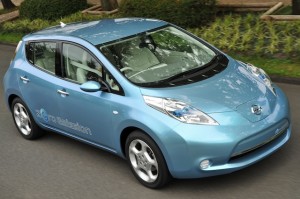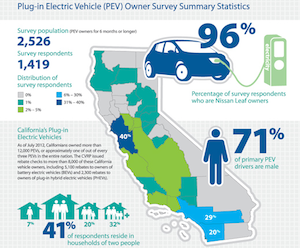 My wife and I are typical of the average U.S. household by owning two cars. We’re different in making one of them an electric car. For the past 18 months, our Nissan Leaf has been our primary car. The person driving the most miles for the day, yet stay under 60 miles, takes the car. The other is typically using transit, working at home, or using our hybrid car. Because we have two cars, electric range is rarely an issue. Only for long distance trips does our hybrid become the primary car.
My wife and I are typical of the average U.S. household by owning two cars. We’re different in making one of them an electric car. For the past 18 months, our Nissan Leaf has been our primary car. The person driving the most miles for the day, yet stay under 60 miles, takes the car. The other is typically using transit, working at home, or using our hybrid car. Because we have two cars, electric range is rarely an issue. Only for long distance trips does our hybrid become the primary car.
Some electric car owners only have one car. They are owned by a single person, or in households, often urban, where one car meets the needs of two or more people. In cities and university towns, these EV drivers also have a range of other vehicles in nearby car sharing parking spaces.
Most early adopters of electric cars are in California, just as they were in first adopting hybrid cars. Data on the driving behavior of some 1,400 Nissan Leaf drivers, and 60 other EV drivers, is now available from the Center of Sustainable Energy of California (CCSE). Here are the results of their extensive survey:
- 89% of owners use their plug-in vehicle (PEV) as their primary car
- They drive an average of 800 electric-fueled miles per month.
- Many Leaf owners pay the equivalent of $0.90 to $1.90 per gallon of gasoline to power their electric vehicles.
- 12,000 electric cars in California save 350,000 gallons of petroleum every month.
- About 67% of vehicle charging takes place in off-peak hours (8:00 p.m. to 8:00 a.m.).
- 39% of the state’s PEV owners have home solar energy systems, another 17 % plan to add solar, helping charge their electric cars.
- 71% of PEV owners report having access to either public or workplace charging or both.
California utilities own large natural gas and nuclear power plants that are most cost effective to run 24/7. There are no coal power plants in California. The nighttime charging of electric cars actually helps utilities balance their load. Utilities have had to add some $8,000 transformers in neighborhoods with electric cars. So far, plug-in vehicles have been helped utilities be more efficient.
 These 1,419 drivers represent a significant sampling of California’s current 12,000 electric car drivers and of the nation’s almost 40,000 electric car drivers. The survey targeted those who had owned their EVs for at least six months. I was one who completed the survey. The results are quite useful, but skewed by the sampling. 96 percent of the survey is Nissan Leaf owners, 95 percent owned a second vehicle, and 71 percent are male.
These 1,419 drivers represent a significant sampling of California’s current 12,000 electric car drivers and of the nation’s almost 40,000 electric car drivers. The survey targeted those who had owned their EVs for at least six months. I was one who completed the survey. The results are quite useful, but skewed by the sampling. 96 percent of the survey is Nissan Leaf owners, 95 percent owned a second vehicle, and 71 percent are male.
They vast majority charged their car in their owned garage, with 97% living in homes with garages. My wife and I are in the small minority of electric car owners who live in multi-tenant buildings, where utility and city inspector approvals can be challenging, and expensive utility commercial rates can apply. Since most city dwellers live in multi-tenant buildings, this will be a major challenge in electric car adoption.
As advertised by Nissan, our Leaf, in real world driving, has delivered a range of 100 miles when driving below 40 miles per hour, but only 60 miles range on freeways. I have taken it up to 80 miles on freeways by charging at the destination, or charging while spending an hour or two at lunch, dinner, or working at Starbucks.
Range Anxiety is Real but Overrated
Most of these California early adopters were dissatisfied with the public charging infrastructure. As a member of both the ChargePoint and Blink Networks, I have found it easy to find charging stations using Google Maps, the apps from my two networks, and with my LEAF’s navigation system. With one exception, the public ChargePoint stations have worked great in a dozen locations. Generally, the Blink stations were “on the blink” when I arrived.
In the five largest California utilities, PEV owners pay about $0.09 – $0.15 per kWh to charge their PEVs at home during off peak hours (at night) and about $0.17 – $0.34 to charge their PEVs on peak (during the day). In California, 90 percent of public charging has been free. The majority surveyed would pay 2.5 to 3 times their home charging rate for “critical need” public charging.
To accelerate electric car adoption and charging infrastructure adoption, the California State Assembly and Senate have passed three bills currently pending Governor Brown’s signature. AB 2405 allows single-occupant, clean and zero emission vehicles with a Clean Air Vehicle Sticker free access to carpool lanes that are converted to toll roads. AB 2502 allows car dealers to include the cost of accelerated electric vehicle charging stations and installation within electric vehicle purchase financing. AB 2853 requires the state to develop a plan for equipping state owned parking lots and park and ride lots with electric vehicle chargers and alternative fuel infrastructure. On September 13, CALSTART will be hosting an event to promote these bills.
Electric-car range is a big concern for most electric car shoppers. After 18 months, I learned that may range anxiety was considerably overblown. Several factors make range less of an issue:
- Owning a second car.
- Driving a plug-in hybrid.
- Electric car chargers at work.
- Network of public charging (over 2,000 public chargers in California).
- Living near transit or car sharing.
Californians are now buying and leasing over 1,000 electric cars monthly from Nissan, Chevrolet, Toyota, Ford, Tesla, and a number of automakers. Now that electric cars are available nationally, about 3,000 electric cars are added monthly in the United States. The CCSE survey shows the potential of electric cars to lower monthly cost of operating a car, range being a small issue in two-car households, benefits to electric utilities, oil dependency and energy security.

0 thoughts on “Electric Car is Primary Car for 89% of Nissan Leaf Drivers”